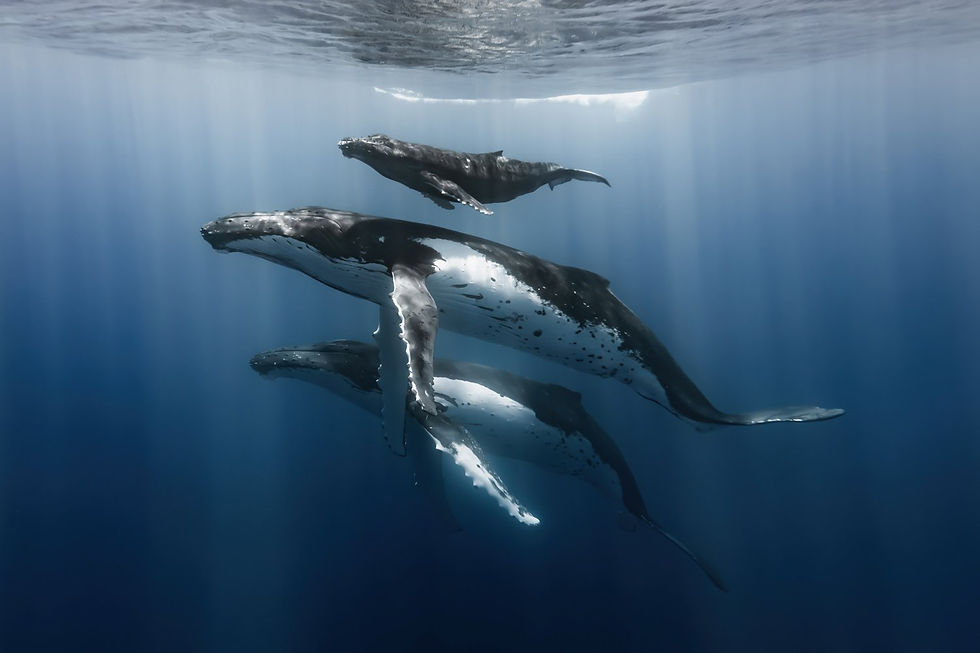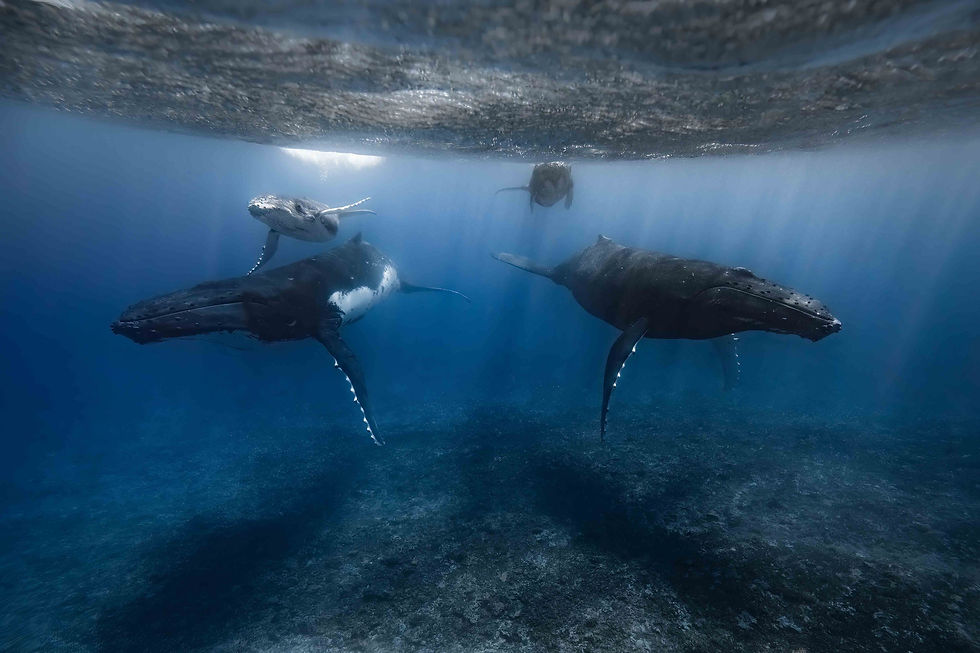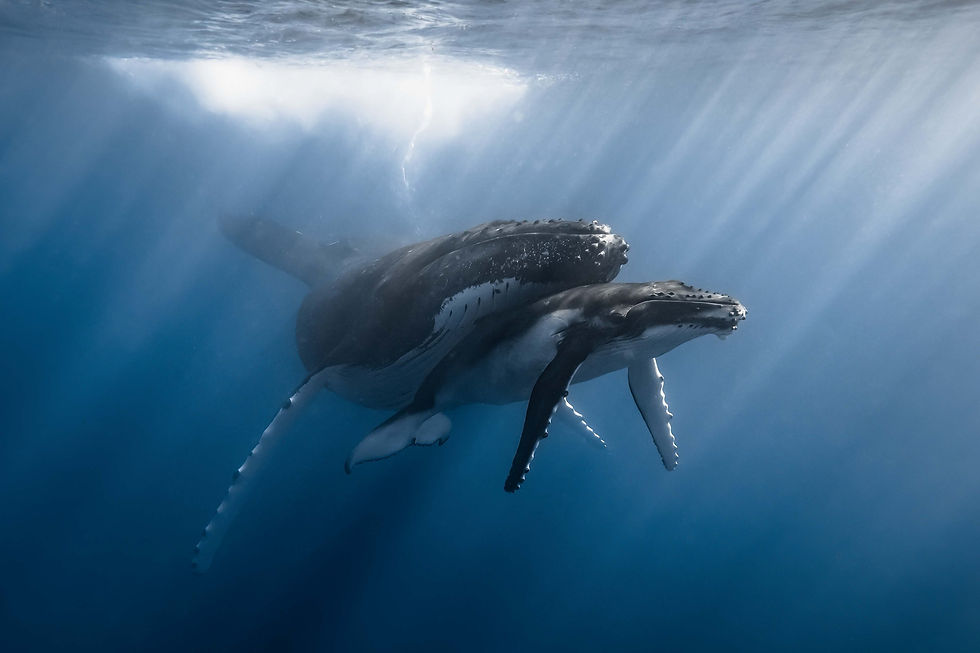Guardians of the Deep: Lessons from Humpback Whales on Conservation and Connection
- Rachel Moore

- Mar 5
- 4 min read
Updated: Sep 12
The vast expanse of the ocean often feels like an endless frontier, teeming with mystery and life. For me, this boundless blue world has been more than just a backdrop for exploration—it has been a teacher, a refuge, and a call to action. Among its many inhabitants, the humpback whale has left an indelible mark on my heart and shaped my commitment to ocean conservation. These magnificent creatures, with their haunting songs and gentle curiosity, embody the fragility and resilience of marine ecosystems. Through my years of diving, documenting, and advocating for marine life, I’ve come to see them not only as symbols of the ocean’s beauty but also as urgent reminders of the need for protection and coexistence.

A Transformative Encounter with Humpback Whales
My journey with humpback whales began in the waters of French Polynesia, where their annual migration transforms the seas into a theater of life. Floating in the water alongside a 40-ton animal that moves with the grace of a ballerina is a humbling experience. In one unforgettable encounter, a mother whale—her calf nestled beside her—paused, tilted her massive body, and locked her eye on mine. In that moment, I felt an overwhelming connection that transcended species. It was as if she was asking, “What will you do to protect this world we share?”
This profound interaction was a turning point. It deepened my understanding of the delicate balance that sustains marine life and the threats posed by human activity. Overfishing, plastic pollution, and climate change are no longer abstract issues when you witness their impact firsthand. Coral reefs bleached into ghostly white wastelands and once-abundant fish populations dwindling to near extinction are stark indicators of an ocean in crisis.
The Vital Role of Humpback Whales in Ocean Ecosystems
Humpback whales are not just awe-inspiring creatures; they are integral to the health of marine ecosystems. Often referred to as ecosystem engineers, whales play a vital role in nutrient cycling. Their movements through the water column—known as the “whale pump”—bring essential nutrients from the depths to the surface, fueling phytoplankton growth. These microscopic organisms form the foundation of the marine food web and are responsible for producing over 50% of the world’s oxygen. Protecting whales, therefore, has a cascading effect on the health of the planet.

Growing Threats to Humpback Whales and Marine Life
However, these gentle giants face numerous threats. Entanglement in fishing gear, ship strikes, and noise pollution disrupt their natural behaviors, while climate change affects their food sources. Conservation efforts must address these challenges with a multifaceted approach, combining science, policy, and public engagement.
Thankfully, there are glimmers of hope. Innovative initiatives worldwide are making strides in marine conservation. In French Polynesia, the establishment of large marine protected areas (MPAs) has provided a sanctuary for humpback whales and other marine life. These MPAs limit human activities like industrial fishing and shipping, creating safe havens for breeding and feeding.
Editor's Note
Renowned photographer and ocean advocate Rachel Moore captured a stunning close-up of a young humpback whale’s blue eye near Tahiti. Affectionately dubbed “Sweet Girl” by Moore, this young whale tragically lost her life in a ship collision just two days after the encounter—a heartbreaking event that underscores the urgent need for marine conservation. Moore’s experience not only fuels her passionate advocacy for stricter ship speed limits along critical whale migration routes but also serves as a powerful reminder of the broader importance of conservation. This tragic loss highlights how vulnerable our ocean giants are to human activities, and it reinforces the call for immediate action to protect marine habitats and preserve our planet’s natural heritage for future generations.

Science, Technology, and Community in Conservation Efforts
Technology is also playing a pivotal role. Acoustic monitoring systems track whale songs and movements, helping scientists understand their migration patterns and identify critical habitats. These insights inform policies to mitigate ship strikes and reduce noise pollution. Additionally, collaborations between local communities, scientists, and conservation organizations are fostering stewardship and sustainable practices.
While science and policy are crucial, I’ve learned that stories have unparalleled power to inspire change. Through photography and storytelling, I aim to bridge the gap between people and the ocean. A single image—like the soulful gaze of a whale—can ignite empathy and motivate action in ways that data alone cannot. Social media has amplified this impact, allowing me to reach a global audience and advocate for stronger protections for marine life.
Community involvement is equally important. In many coastal regions, local traditions and livelihoods are deeply intertwined with the ocean. Empowering these communities with knowledge and resources fosters a sense of ownership and responsibility. For example, eco-tourism initiatives that prioritize ethical wildlife interactions provide economic benefits while promoting conservation.

How We Can All Help Protect Our Oceans
The fight to protect humpback whales and marine ecosystems is not one we can afford to lose, but it’s a battle that requires collective effort. Here are a few ways we can all contribute:
Support Sustainable Practices: Choose seafood from sustainable sources and avoid products that exploit marine life.
Reduce Plastic Use: Minimize single-use plastics to prevent pollution that harms marine animals.
Advocate for Policy Change: Support legislation that protects marine habitats and regulates harmful practices.
Participate in Citizen Science: Join beach cleanups or contribute to data collection efforts.
Spread Awareness: Share stories, images, and information to inspire others to care for the ocean.
The ocean covers over 70% of our planet, yet it remains one of the least understood and most threatened ecosystems. Humpback whales remind us of the interconnectedness of life on Earth. Their survival is tied to the health of the oceans, which, in turn, sustains us all. As we sail through this era of environmental challenges, we must recognize our shared responsibility to protect the natural world. By working together—as individuals, communities, and global citizens—we can ensure that future generations inherit a thriving ocean teeming with life and wonder.
In the end, the question remains: What will we do to protect this world we share?

_edited.png)






what an inspirational person you are Rachel!
Very impressive!🌊
How close were you to take that eye capture? Aren't they afraid or bothered or aren't you?
Should protect these gentle giants in all costs…
I was very impressed. All living things should live in safety.👏👏👏👏